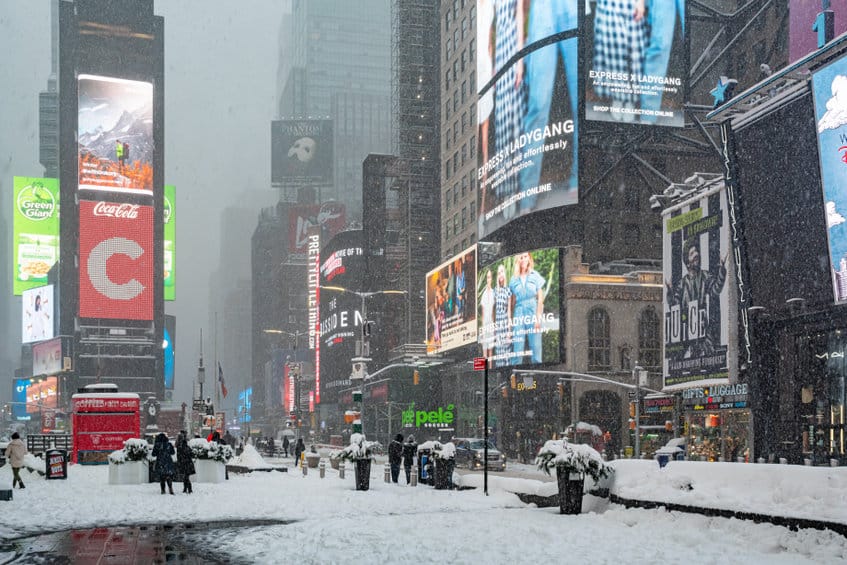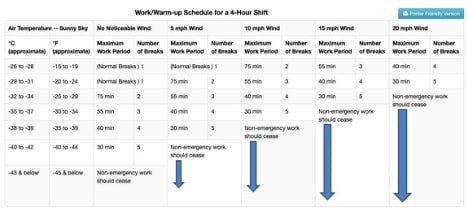NYC Construction Winter Weather Hazards

Winter weather hazards can lead to treacherous working conditions in the construction industry, especially in New York City. Ice, snow, and sleet coat surfaces and equipment, making them slippery and hard to handle. On top of that, arctic blasts bring frigid temperatures that lead to cold-related illnesses and injuries.
Unfortunately, most construction workers do not slow down in the winter. Construction sites are active all year round, and tradesmen work tirelessly to meet their deadlines. When inclement weather hits, outdoor tradesmen still need to complete the same hazardous jobs they would on any other day.
Employers who do not prepare their worksites for cold-weather hazards put their employees at an increased risk of construction accidents. These weather-related challenges require special preparations to prevent injuries. Knowing the most common winter hazards and how to prepare for them can significantly decrease the rate of accidents on outdoor worksites.
5 Construction Winter Weather Hazards To Avoid
Winter in New York City is volatile and unpredictable. Regardless of which construction trade you practice, these five common winter weather hazards notoriously lead to accidents every year
Snowfall
Snow can build up quickly and turn to ice if left on surfaces with varying temperatures. Removing snow from equipment and surfaces is essential to preventing slip and fall accidents, but incorrectly removing snow can also lead to severe injuries.
Shoveling snow is no easy undertaking. According to FEMA’s Snow Load Safety Guide, light and fluffy snow can weigh up to three pounds per square foot, while heavy snow topped with ice weighs almost 57 pounds per square foot. When using these ratios to describe shoveling an average 10ft x 18ft driveway, the person shoveling would be removing 10,000 pounds of snow.
The National Safety Council (N.S.C.) reports snow removal is responsible for 100 fatalities and thousands of injuries every year. Snow accumulation can be inconsistent in New York, with some storms dropping over 5 inches or more in one day. Having a reliable snow removal plan in place is essential for construction sites to ensure a safe worksite at all times. For large worksites, employers should make arrangements for snow removal that do not include their employees to reduce strain and the risk of injuries. According to the Occupational Safety and Health Administration (O.S.H.A.), workers who remove heavy snow can sustain catastrophic injuries, including:
- Amputations
- Eye injuries
- Back over accidents (snowblower-related)
- Tip-over accidents (snowblower-related)
- Hypothermia from cold temperatures
- Electrocution injuries from hitting live wires
- Muscle and bone injuries
- Heart attacks
- Fall injuries
If it’s not possible to hire a professional snow removal service, employers can use these safety
recommendations from the N.S.C. to reduce the risk of injuries to their employees:
- Dress warmly before removing snow.
- Do not eat or smoke while removing snow. These habits slow your body down and require you to work harder.
- Only shovel fresh, powdery snow. Snowblowers should be used for heavier snow.
- Use long rakes to clear snow to avoid going up on the roof.
- Lift with your legs, not your back, when shoveling.
- Wear work boots with snow traction.
- Work in shifts and take breaks.
Cold Stress
Cold stress is a life-threatening health hazard posing a risk to all outdoor workers during the winter months. The human body is not made to withstand extreme cold without protection. Risk factors such as wet/damp clothing, poorly insulated gear, exhaustion, preexisting health conditions, or lack of physical activity can all result in permanent or even fatal injuries when working in the cold.
The three most common cold stress injuries highlighted by O.S.H.A. include:
Frostbite: A condition involving the freezing of skin and tissue, leading to irreversible damage to the body. Severe cases of frostbite require amputation. Symptoms include reddened skin with gray/white patches in the fingers, toes, nose, or ear lobes, tingling, aching, and loss of feeling.
Hypothermia: This condition occurs when a worker’s average body temperature, typically 98.6 degrees, drops to less than 95 degrees. Cold weather causes the body to lose heat faster. Symptoms include uncontrollable shivering, loss of coordination, confusion, slurred speech, slowed heart rate and breathing, and the inability to think clearly.
Immersion/Trench Foot: This non-freezing injury occurs after prolonged exposure to wet and cold conditions. Symptoms include reddening skin, tingling, swelling, pain, leg cramping, numbness, and blisters.
Cold stress injuries can have a significant impact on a worker’s health. Employers are responsible for taking weather into account when scheduling daily breaks to ensure workers take adequate warm-up breaks and stay indoors entirely when the risk of cold-weather injuries is too high.
O.S.H.A. provides the following recommendations for warm-up schedules to be used for non-emergency outdoor workers:
(IMG Credit: O.S.H.A.)
Winter Driving Accidents
Winter weather hazards make for dangerous driving conditions. According to the Federal Highway Administration (F.H.A.), approximately 24 percent of car accidents nationwide are caused by winter weather-related factors every year. Among these accidents, more than 1,300 result in fatalities, while 116,800 lead to various injuries.
While all winter weather poses a risk for accidents, some types are more hazardous than others. Another study by the F.D.A, conducted over 10 years, examined 1,235,145 winter weather-related crashes from 2007 to 2016. Below are their findings:
- 70% of accidents resulted from wet pavement.
- 18% of accidents resulted from snow/sleet on the pavement
- 16% of accidents resulted from snow/slush on the pavement
- 13% of accidents resulted from icy pavement
The winter weather hazard with the highest rate of fatal accidents was wet pavement, a road condition that frequently occurs (if not daily) during the winter months. Fluctuating temperature can lead wet pavement to freeze quickly, increasing the likeliness of black ice. Black ice is nearly transparent, making it hard for drivers to detect, especially at night.
While drivers can do their best to prevent road accidents, some winter weather conditions are unavoidable. Employers can keep workers safe on the road by enforcing various driving safety policies that prepare workers for whatever weather may come their way. Some of these steps, suggested by the NYS Department of Transportation, include:
- Enforcing an effective maintenance program for all company vehicles and mechanized equipment.
- Requiring all vehicles to carry an emergency kit in the case of an accident.
- Training workers on operating work vehicles in the snow/winter weather.
- Keeping roads on and around the worksite clear.
- Using barrels and barriers to mark the roads and provide guidance when snow covers the worksite.
Employees should not expect workers in non-emergency trades to risk their lives by driving in inclement weather. When dangerous weather is in the forecast, employers can keep workers safe by delaying travel to work and while on the job to avoid accidents.
Falls On The Ice
Falls are the leading cause of construction accidents and fatalities reported in O.S.H.A.’s “Fatal Four” every year. Packed down snow and ice elevate the risk of slip and fall accidents on the worksite and increase the severity of injuries sustained when a fall occurs. Some of the most traumatic injuries workers have reported from slipping on the ice include:
- Bone fractures
- Soft tissue damage and torn ligaments
- Severe Lacerations
- Traumatic Brain Injuries
- Spinal Cord Injuries
- Death
Prompt removal of snow and ice on the worksite is essential to preventing cold weather-related slip and fall accidents. The longer snow sits on surfaces, the more packed down and frozen it becomes. Shoveling, snow blowing, and salting walkways and roads reduces ice accumulation and allows workers to walk safely around the construction site.
In circumstances where snow and ice build-up quickly, workers will need to take additional steps to reduce their risk of falling. Some of these include:
- Take shorter steps when walking on ice and snow.
- Use handrails on stairs.
- Never climb icy ladders.
- Make sure to use fall protection whenever on elevated platforms or scaffolding.
- Wear work boots and gloves with good traction.
Melting Dangers
Massive ice and snow melts throughout the year can pose deadly conditions for workers on job sites with rooftops and other surfaces prone to snow accumulation. Temperatures in NYC are never consistent and constantly fluctuate between above and below freezing.
After heavy snowstorms, warmer temperatures can lead to falling icicles and sliding snow drifts from tall buildings that can fall on workers below. Studies show at least 15 people die every year from falling icicles, and thousands of injuries from similar accidents are likely unreported.
To help prevent injuries caused by falling ice and snow, employers should keep all roofs and ledges clear. Icicles can become extremely dangerous the larger they grow. Making sure to clear any water accumulation on rooftops or growing icicles on ledges can help reduce the chance of them falling on unsuspecting workers. Never try to knock down icicles or snow drifts while standing directly under them.
To remove snow and ice from elevated surfaces, O.S.H.A. suggests hiring a professional snow removal service with a lift or professionally training employees to use aerial lifts to access rooftops safely. De-icing materials can also be effective in reducing snow and ice build-up on elevated surfaces.
When ice removal is in process or has yet to begin, employers can mark off any areas on the worksite where snow and ice tend to slide off rooftops. This way, employees can avoid impact areas and reduce their chance of sudden injuries.
New York City Construction Accident Attorneys
Injuries sustained from cold weather-related accidents can be prevented by following strict safety measures on the job. Employers who neglect to provide safe working conditions in the winter put construction workers at an unnecessary risk for injuries.
At the law firm of Pazer Epstein Jaffe Fein & Gozenput, P.C., we have been fighting for New York City workers and victims of construction accidents for over 60 years. If you or a loved one has sustained a serious injury on a construction site, our experienced trial attorneys are here to help. Contact us for a free consultation anytime through our online form or call 212-227-1212 to review your case and your rights.
Related Posts
Categories
